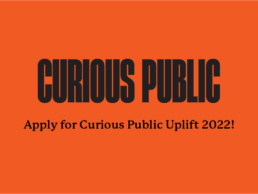This year has been quite the decade.
Elon Musk made the mother of all late-night impulse buys. Kanye West burned his sneaker empire to the ground. Ukrainian tractors emerged as apex predators. Loud, obnoxious honking Canadians descended on Ottawa – and for once, they weren’t geese. Ryan Reynolds decided he should sing and dance in a musical – and he was great at it, of course.
And in the world of communications, there were lots of lessons to learn. But for all of us at Curious Public, three big themes stood out:
Theme 1: The Hybridization of Work
The hybrid work model created opportunities and challenges for marketers this year. Markets could no longer target droves of working-age Canadians by geography or commuter habits. Offline marketing had to pivot. Again. But screen-fatigued people also couldn’t be counted on for the same levels of lock-down digital engagement this year.
The campaigns, ads, and product launches that stood out in 2022 were the ones that tapped into the new zeitgeist.
Refreshed Value Propositions:
Regions and municipalities had a real opportunity to refresh their value proposition to attract new residents now that work and location are less tethered. A campaign we enjoyed this year came from Sudbury, Ontario. Sudbury’s omnichannel Hit Refresh campaign went beyond the worn-out messaging of “cheaper houses here.” Instead, Sudbury’s campaign tapped into the psychology of younger, working-age post-pandemic Canadians. The campaign spoke to our desire for a deeper connection to where we live while doing the work we love.
Campaigns That Kept Pace with the Pulse:
The Angus Reid Institute found that more than half of Canadians said they would start looking for a new job if asked to return to the office. But attitudes gradually shifted as the year went on. Canadians came to prefer hybrid work – especially men – according to a report prepared by our friends at the Future Skills Centre.
Two great advertising campaigns that kept pace with the pulse were from American information technology company Hewlett-Packard (HP) and IKEA Canada.
Last winter, HP worked with Wieden+Kennedy to produce the No Thought Left Behind campaign. The featured ad in this campaign calls attention to the perceived challenges of hybrid collaboration – voicelessness, isolation, and disconnection. HP offers its latest video conferencing technology as a possible fix. ¯\_(ツ)_/¯
But HP switched up the tenor and style in the summer when they worked again with Wieden+Kennedy to develop the global Work Happy campaign – a delightful satire of the “rules of hybrid work.” HP stayed in sync and came out on top.
IKEA Canada similarly debuted its Office Home campaign this past August. The summer was a pivotal hyb-motional time when people were preparing to leave their sweatpants and slippers at home for at least some of the week. The social-led campaign featured short, fun videos which posed the question on everyone’s mind: “Missing the comfort of working from home?” The Office Home campaign promised Canadians a joyful, creature-comfort-filled transition back to the office – slippers included!
Promotional Trends On Our Radar for a Hybrid 2023:
Working (and living) in a hybrid model is here – at least for a few years. Here’s what we can lean into for our 2023 hybrid reality.
-
Brand Activations and On-site Branding
On-site activations ranging from experiential marketing to conferences are back, but they’ll still have to include digital for greater inclusivity.
Mission critical: stay COVID safe, be inclusive, and design for exceptional online and in–person connection.
-
Digital Out of Home (DOOH) Advertising
Kenneth Research predicts that the DOOH market will grow by 12% over the next ten years. That prediction is largely because DOOH is flexible, cost-effective, highly customizable and dynamic – an essential during the pandemic-led uncertainty of campaign shelf-lives. Marketers are leaning in and apparently gearing up to double their spending on this tactic next year, according to Insider Intelligence.
Mission critical: DOOH offers creativity, is highly customizable, and can be value-driven by incorporating real-time data into brand messaging.
-
Video Content
It’s still number one – especially with every social platform offering (and rewarding) video sharing. And 87% of marketers say video delivers a high ROI in 2021 compared to just 33% who champed the tactic in 2015, according to a survey from Wyzowl.
Mission critical: closed captioning is table stakes; research the landscape and context of each platform’s trends before capitalizing on them, and keep your content short and snappy. A video that’s under 3 minutes is “the sweet spot.”
-
Direct Mail
This offline marketing tactic is becoming increasingly popular in our hybrid world. Research and Markets found that the global direct mail market reached almost $43 million in 2021. The firm predicts the direct mail market will grow to $46 million in 2026 at a rate of 1.6%. The year 2023 may not yield the same as 1980, when marketers allocated 42% of their budget for direct mail, but the offline tactic is definitely not over.
But here’s why we like direct mail: it offers people a tangible and tactile experience with your brand – you get that right, and you’re gold.
Mission critical: pair with a digital component for tracking metrics (a QR code or landing page link), think through the physical experience you want to deliver to people and invest in design.
Consider how these tactics can help you diversify your reach in 2023 – especially if your business is foot-traffic or travel-for-work dependent.
Theme 2: A Looming Recession
Bank of Canada Governor Tiff Macklem laid out both the rock and the hard place of 2023 in his year-end speech: “If we raise rates too much, we could drive the economy into an unnecessarily painful recession and undershoot the inflation targets. If we don’t raise them enough, inflation will remain elevated, and households and businesses will come to expect persistently high inflation.”
All of us feel the discomfort of budget belts tightening. And marketing and communications departments are traditionally amongst the first to suffer the squeeze – but cutting your marketing budget may not be in your best interests.
And here’s why:
The current Consumer Confidence Index is recording the same dip in consumer confidence as during the 2008 crash and the beginning of the COVID-19 pandemic (Source: OECD Data)
When consumer confidence drops, companies dial back their marketing spending. But here’s the thing: brands that double down when everyone’s cutting often prevail.
Kantar Millward Brown reported that brands that ceased to spend on marketing and advertising during the 2007-08 financial crisis experienced a brand use decrease of 24% and a brand image decrease of 28%. Read more in their 2008 report, “Marketing During a Recession: To Spend or Not to Spend?”
McGraw Hill’s research study found that companies that increased marketing and ad spending during the 1980-85 recession had much higher sales once the economy regained its feet. Read their findings here.
VRBO is a tremendous example of McGraw Hill’s findings. Airbnb was the industry leader pre-pandemic, but they cut their spending as travel shut down. But not the challenger, VRBO. VRBO increased their spending 10-fold over Airbnb. VRBO’s bookings recovered by 61% during January – February of 2021 when travel started to open. But Airbnb’s bookings dropped by 15% in the same period.
Historical brands that spent in tough times:
- Post dominated the cereal market in the first quarter of the last century. But they cut their marketing spending when the Great Depression hit. Kellogg’s did not. Kellogg doubled its spending and launched a new product (Rice Krispies). Its profits grew by 30%.
- FedEx opened their doors in the oil crisis (and eventual recession) of 1973. They had three major attributes going for them. One, they didn’t use gas-heavy transport. Two, they could deliver overnight. Three, they let people know it with strong marketing and communications campaigns.
- McDonald’s dropped its ad spending when the recession hit in 1991, but Taco Bell and Pizza Hut doubled down. Pizza Hut’s sales increased by 61%, and Taco Bell’s grew by 40%. All while the golden arches’ sales fell by 28%.
Theme 3: The Need for Hope
Hope seemed in short supply this year. War, famine, poverty and hardship were everywhere. Anyone who can help us feel hopeful next year will stand out – because we need it.
Hope – real hope – comes from creation and then communication.
Creating Hope
What tangible actions can you take this year to increase feelings of connectivity and belonging? Will you create a plan for corporate social responsibility or corporate activism? (If your company doesn’t yet have a plan, you might want to read why it’s imperative in these insights from our friends at Weber Shandwick.)
Will you double down your efforts on meaningful internal communications to ward off the quietly quitting sentiments? Like through increased pulse surveys, staff acknowledgements, open forums for shared ideas and creativity, or team professional development sessions?
Or will you carve out your own personal path by volunteering, mentoring, or finding other ways to make a positive change in your corner of the universe?
Whatever you choose, it starts with concrete actions.
Communicating Hope
Once you’ve chosen your action, dare to tell people about what you’re doing and why. And invite them to join you. Because here’s the thing, our world will never be flawless. But it will improve when more people envision how they and others can get to work, making it better.
Communicating a message of hope is to communicate a sturdy message of action – a conviction and path forward against the status quo. Fear-mongering can always stir the pot, but hope will move the mountain.
Maya Angelou said of hope, “Hope and fear cannot occupy the same space. Invite one to stay.”
From all of us at Curious Public to all of you: have a healthy, happy and hopeful new year.
Lloyd Rang
President and Narrative Lead for Curious Public. Lloyd is one of Canada’s leading communications and crisis management experts.


